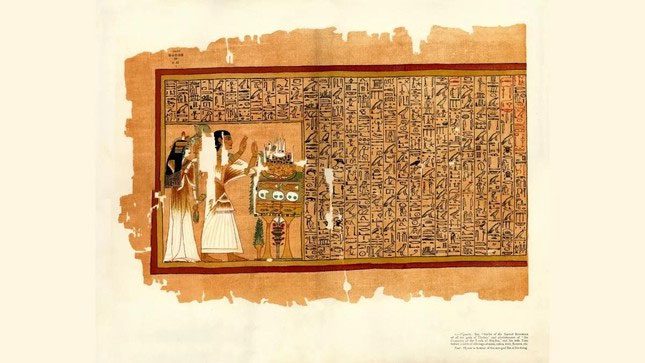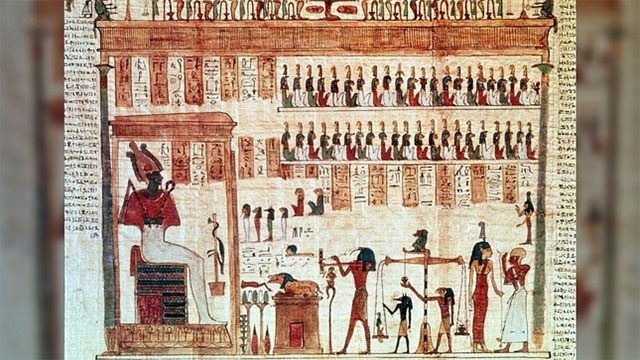“The Book of the Dead” is the modern name given to a collection of ancient Egyptian texts that the Egyptians believed would help the deceased navigate the afterlife. Copies of these texts were sometimes buried with the dead.
“The Book of the Dead” became popular during the New Kingdom period, but it has its roots in the “Coffin Texts” and “Pyramid Texts” that were inscribed on the walls of pyramids. The Coffin Texts were common during the Middle Kingdom (around 2030 BCE to 1640 BCE), while the Pyramid Texts first appeared in the Fifth Dynasty of the Old Kingdom (around 2465 BCE to 2323 BCE).

A papyrus manuscript with hieroglyphs in cursive and colored illustrations. Here, we see Ani, the scribe of the Sacred Revenues of all the gods of Thebes, and the steward of the granaries of the Lords of Abydos, along with his wife Tutu, in front of an offering table filled with meat, bread, fruit, flowers, and more.
Spells to Assist the Dead in the Afterlife
“The Book of the Dead” consists of individual chapters, or spells. The ancient Egyptians used the term “spell”, written in hieroglyphs that resemble a human mouth, as this term is associated with speech.
There is no standard book found in every tomb. Instead, each copy contains different spells. There is no single book that contains all known spells; rather, it is a reasonable sample, and no two copies are alike.
The ancient Egyptians referred to these texts as “The Book that Will Come Every Day”, reflecting their belief that the spells provided support for the deceased to transition into the afterlife as a glorified soul.
Barry Kemp, an honorary professor of Egyptology at the University of Cambridge, England, and author of “How to Read the Egyptian Book of the Dead,” writes: “Some spells appear more frequently in copies of ‘The Book of the Dead’ than others, and some are considered almost essential. One of these important spells is now known as Spell 17, which discusses the significance of the sun god Re (also known as Ra), one of the most important Egyptian deities.”
The ancient Egyptians believed that the body of the deceased could be transformed in the afterlife so that one could move to a place with “gods, demons, mysterious locations, and potential obstacles.” The chapters of “The Book of the Dead” describe various challenges one might encounter—such as the heart-weighing ceremony, where a person’s actions are balanced against the feather of the goddess Maat, a deity associated with justice.
The spells are often illustrated. Geraldine Pinch, an Egyptologist, wrote in her book Egyptian Myth: “The very brief introductions to the images are of great importance in the honorific text collection of the New Kingdom, now known as the Book of the Dead.” (Oxford University Press, 2004).”
“Many owners of ‘The Book of the Dead’ could not read the hieroglyphic texts, but they could understand the intricate patterns summarizing the content of the spells.”
Also Applicable for the Living

A section of “The Book of the Dead.” Here we see the judgment of the dead, with the brain-weighing ritual.
“The Book of the Dead” is most famous for guiding the deceased, but it also served other purposes. Perhaps the most important function of the book can only be inferred from indirect evidence: it alleviated people’s fears about the mysteries of death. Wealthy ancient Egyptians also arranged for mummification and decorated their coffins with religious texts in an effort to control what happened to them after they died.
Moreover, the spells in “The Book of the Dead” could be used while a person was still alive. Most spells in the book were not designed to ‘navigate’ the afterlife. Most spells pertain to transformation and transcendent experiences. In earthly life, a person following rituals could use the rites and spells to transcend daily experiences [utilizing spells in a ceremony for a religious experience]. Many spells include guidance on how to use them on Earth, indicating that they could also be employed by the living.
The ancient Egyptians believed that many of these spells could subsequently be used in the afterlife. A person could use similar spells to help transform their existence, but in many ways, it is a similar transcendent experience. These spells primarily elevate the existence of the gods; only then could the individual journey through the afterlife alongside the gods themselves.
Many copies of “The Book of the Dead” have been discovered during excavations in tombs and have hardly been read. Furthermore, many manuscripts of “The Book of the Dead” that still exist today were likely not read extensively before being buried with the deceased.
Additionally, the spells in “The Book of the Dead” were not always written out on manuscripts. For example, spells were sometimes inscribed on the wrappings of a mummy. They were also carved on the walls of tombs and even on the gold death mask of Tutankhamun…
The last known copies of “The Book of the Dead” were created in the first or second century CE. A series of other texts known as “The Book of Breath” became popular, partly derived from “The Book of the Dead.”





















































